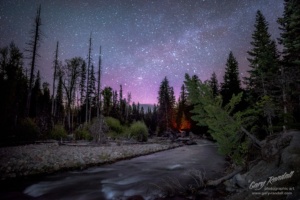Oregon Aurora – The Northern Lights in the Pacific Northwest – There once was a day when I was asked, “What would be your dream shot?” I replied that my dream shot or the impossible shot would be the aurora over Mount Hood, Oregon.
Since then Earth has passed into the peak of the solar cycle known as solar maximum and camera sensors have become much more sensitive to light allowing myself and many other photographers to be able to photograph the event when it happens, and it has happened quite a bit the last three years. The first time that I photographed the aurora I had no idea that I had captured it in the shots that I had made the night when I went to photograph Trillium Lake, but when I looked at the photos when I had returned home I noticed a green glow on the horizon. Granted, it wasn’t columns and ribbons of light, but a soft green glow. That was October 24th, 2011. Four years ago.
Since then I have been able to catch the Northern Lights in the area and snap a few photos. It’s not as easy as just taking a chance and going and to get a photo. They only come after a solar storm and typically happen from a day or three afterward. I use an application for my phone called Aurora Notifier that signals me when the Kp level, the strength, of the aurora rises above 4Kp. Once that happens, if it’s a dark night, I grab my gear and go.
Once out in the dark one must realize that at this latitude the light is dim and difficult to see with your eyes, but if it’s a strong enough display you can see the light pillars dance on the horizon once your eyes are adjusted. You must get away from any sky whose darkness is diluted by any affect from town or city light. Even the light from the moon can wash out the northern lights. Choose a dark sky with a view toward the northern horizon. Set your camera on a tripod and set your aperture wide open to allow as much light in as possible. Then set your ISO high, it will vary depending on how dark the sky is or how bright the aurora is. Then set your shutter speed for at least 20 seconds. This long exposure is only for the aurora at this latitude. When photographing the aurora in the northern latitudes where the aurora is much brighter a much shorter exposure is called for.
Once you have your camera set take a shot and see how it looks on your preview screen. If it’s too dark raise your ISO or extend your shutter time, from 20 sec to 25 sec for instance. If it’s too bright lower your ISO. That should get you started. There are challenges that you will run into but in time you will get some northern light shots for your own.
Below is a collection of some of my Oregon Aurora photos. I hope that you enjoy them.
No color was added to any of these photos.
Enjoy!
Gary =0)




